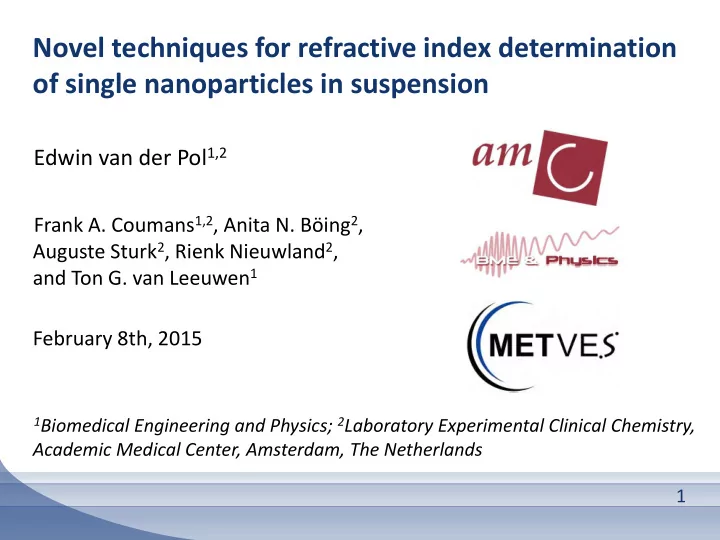

Novel techniques for refractive index determination of single nanoparticles in suspension Edwin van der Pol 1,2 Frank A. Coumans 1,2 , Anita N. Böing 2 , Auguste Sturk 2 , Rienk Nieuwland 2 , and Ton G. van Leeuwen 1 February 8th, 2015 1 Biomedical Engineering and Physics; 2 Laboratory Experimental Clinical Chemistry, Academic Medical Center, Amsterdam, The Netherlands 1
Acknowledgements Academic Medical Center University of Oxford Biomedical Engineering and Physics Chris Gardiner Laboratory Experimental Clinical Chemistry University of Birmingham Paul Harrison European Association of National Metrology Institutes (EURAMET) NanoSight Ltd. The European Metrology Research Patrick Hole Programme (EMRP) is jointly funded by Andrew Malloy the EMRP participating countries within Jonathan Smith EURAMET and the European Union 2
Introduction to extracellular vesicles cells release vesicles (e.g. exosomes): biological nanoparticles with receptors, DNA, RNA specialized functions clinically relevant van der Pol et al., Pharmacol Rev (2012) 3
Add extracellular vesicle concentrations to hematology reference tables Source: Academic Medical Center 4 4
Determine refractive index to identify vesicles vesicles (1.36 ≤ n ≤ 1.45 for d > 500 nm)* lipoproteins ( n = 1.45-1.60) protein aggregates ( n = 1.53-1.60) * Konokhova et al., J Biomed Opt (2012) 5
Refractive index to relate scatter to diameter 3 flow cytometry is widely used to detect single vesicles refractive index provides scatter to diameter relation Coumans et al., SPIE2015 #9315-6 6
Refractive index of vesicles is unknown ? refractive index of vesicles is unknown detection range is unknown Coumans et al., SPIE2015 #9315-6 7
Methods for refractive index determination of single nanoparticles in suspension Refractive index matching (multiple particles) 8 8
Methods for refractive index determination of single nanoparticles in suspension vesicles ≥ 500 nm Multi-angle light scattering* (single particles) Refractive index matching (multiple particles) * graph adopted from: Konokhova et al., J Biomed Opt (2012) 9 9
Problem no method to determine the refractive index of single nanoparticles (< 500 nm) in suspension Method Single particles Size (nm) Refractive index matching – All Multi-angle light scattering + ≥ 500 flow cytometry 10 10
Goal determine the refractive index of single nanoparticles in suspension identify vesicles in plasma provide insight in vesicle detection by flow cytometry 11 11
Methods - single particle tracking (SPT) obtain particle diameter d by tracking the Brownian motion of single particles (Stokes-Einstein equation) measure scattering power P derive particle refractive index n(P,d) from Mie theory 12 12
Methods - setup EMCCD Commercial instrument + Nanosight NS-500 microscope objective NA = 0.4 particles in solution laser beam power = 45 mW glass wavelength = 405 nm figure adopted from Malvern Instruments Ltd, UK 13 13
Methods - data acquisition and processing 14
Methods - approach calibration measure light scattering of beads describe measurements by Mie theory validation determine refractive index of beads mixture application determine refractive index of vesicles 15
Results - scattering cross section vs. diameter of polystyrene beads by Mie theory 16
Results - scattering cross section vs. diameter of polystyrene beads 17
Results - scattering cross section vs. diameter of polystyrene and silica beads 18
Methods - approach calibration measure light scattering of beads describe measurements by Mie theory validation determine refractive index of beads mixture application determine refractive index of vesicles 19
Results - scattering cross section vs. diameter of a mixture of polystyrene and silica beads SPT 20
Results - scattering cross section vs. diameter of a mixture of polystyrene and silica beads SPT 21
Results - refractive index and size distribution of a mixture of polystyrene and silica beads SPT 22
Methods - approach calibration measure light scattering of beads describe measurements by Mie theory validation determine refractive index of beads mixture application determine refractive index of vesicles 23
Results - scattering power versus diameter of urinary vesicles SPT 24
Results - size and refractive index distribution of urinary vesicles 25
Conclusions single particle tracking can be used to determine the refractive index of nanoparticles in suspension mean refractive index of urinary vesicles is 1.37 E. van der Pol et al., Nano Lett (2014) 26
Discussion SPT accuracy: measurement error = 2.0 % precision: coefficient of variation (CV) = 2.8 % 27 27
Discussion increase precision by increasing minimum tracklength consequence: number of tracked particles decreases 28 28
Outlook: hybrid backscattering – resistive pulse sensing for refractive index determination backscattering intensity resistive pulse sensing nanopore membrane CV diameter = 7% resistive pulse sensor: commercial instrument (qNano, Izon Ltd) 29
Towards vesicles as biomarkers for disease backscattering intensity fluorescence + Raman scattering* resistive pulse sensing van der Pol et al., SPIE2015, 2:10 PM, #9328-13 30 30 edwinvanderpol.com
Recommend
More recommend